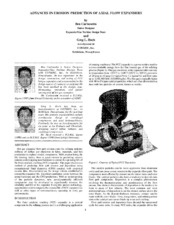| dc.contributor.other | Turbomachinery Symposium (28th : 1998) | |
| dc.creator | Carbonetto, Ben | |
| dc.creator | Hoch, Greg | |
| dc.date.accessioned | 2017-10-05T14:03:22Z | |
| dc.date.available | 2017-10-05T14:03:22Z | |
| dc.date.issued | 1999 | |
| dc.identifier.uri | https://hdl.handle.net/1969.1/163377 | |
| dc.description | Lecture | en |
| dc.description | Pg. 1-8 | en |
| dc.description.abstract | Hot gas expander flow path erosion costs the refining industry millions of dollars per shutdown in labor, material, and lost production to replace eroded components. With erosion being the life limiting factor, there is great interest in predicting erosion patterns and designing new hardware to extend the operating life of the fluid catalytic cracking (FCC) expander. This paper discusses a method of predicting flow path erosion and deposition using computational fluid dynamics (CFD) coupled with empirical erosion data. Also included are the design criteria established to extend the expander life. Excellent correlation exists between the actual hardware and the CFD predictions. With an understanding of the particle dynamics, new aerodynamically efficient components may be developed to significantly increase the reliability and life of the expander. Using this proven technology, opportunities exist to improve the erosion life of FCC expanders as well as other types of turbomachinery operating in dirty gas environments. | en |
| dc.format.medium | Electronic | en |
| dc.format.mimetype | application/pdf | |
| dc.language.iso | en | |
| dc.publisher | Texas A&M University. Turbomachinery Laboratories | |
| dc.relation.ispartof | Proceedings of the 28th Turbomachinery Symposium | en |
| dc.subject.lcsh | Turbomachines | en |
| dc.title | Advances In Erosion Prediction Of Axial Flow Expanders. | en |
| dc.type.genre | Presentation | en |
| dc.type.material | Text | en |
| dc.identifier.doi | https://doi.org/10.21423/R17M11 | |


